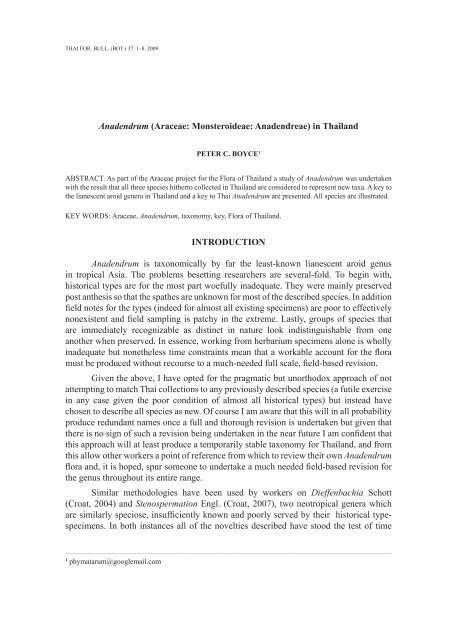Create successful ePaper yourself
Turn your PDF publications into a flip-book with our unique Google optimized e-Paper software.
<strong>THAI</strong> FOR. BULL. (BOT.) 37: 1–8. 2009.<br />
Anadendrum (Araceae: Monsteroideae: Anadendreae) in Thailand<br />
PETER C. BOYCE 1<br />
ABSTRACT. As part of the Araceae project for the Flora of Thailand a study of Anadendrum was undertaken<br />
with the result that all three species hitherto collected in Thailand are considered to represent new taxa. A key to<br />
the lianescent aroid genera in Thailand and a key to Thai Anadendrum are presented. All species are illustrated.<br />
KEY WORDS: Araceae, Anadendrum, taxonomy, key, Flora of Thailand.<br />
INTRODUCTION<br />
Anadendrum is taxonomically by far the least-known lianescent aroid genus<br />
in tropical Asia. The problems besetting researchers are several-fold. To begin with,<br />
historical types are for the most part woefully inadequate. They were mainly preserved<br />
post anthesis so that the spathes are unknown for most of the described species. In addition<br />
field notes for the types (indeed for almost all existing specimens) are poor to effectively<br />
nonexistent and field sampling is patchy in the extreme. Lastly, groups of species that<br />
are immediately recognizable as distinct in nature look indistinguishable from one<br />
another when preserved. In essence, working from herbarium specimens alone is wholly<br />
inadequate but nonetheless time constraints mean that a workable account for the flora<br />
must be produced without recourse to a much-needed full scale, field-based revision.<br />
Given the above, I have opted for the pragmatic but unorthodox approach of not<br />
attempting to match Thai collections to any previously described species (a futile exercise<br />
in any case given the poor condition of almost all historical types) but instead have<br />
chosen to describe all species as new. Of course I am aware that this will in all probability<br />
produce redundant names once a full and thorough revision is undertaken but given that<br />
there is no sign of such a revision being undertaken in the near future I am confident that<br />
this approach will at least produce a temporarily stable taxonomy for Thailand, and from<br />
this allow other workers a point of reference from which to review their own Anadendrum<br />
flora and, it is hoped, spur someone to undertake a much needed field-based revision for<br />
the genus throughout its entire range.<br />
Similar methodologies have been used by workers on Dieffenbachia Schott<br />
(Croat, 2004) and Stenospermation Engl. (Croat, 2007), two neotropical genera which<br />
are similarly speciose, insufficiently known and poorly served by their historical typespecimens.<br />
In both instances all of the novelties described have stood the test of time<br />
________________________________________________________________________________________________________________________________________________________<br />
1 phymatarum@googlemail.com
















